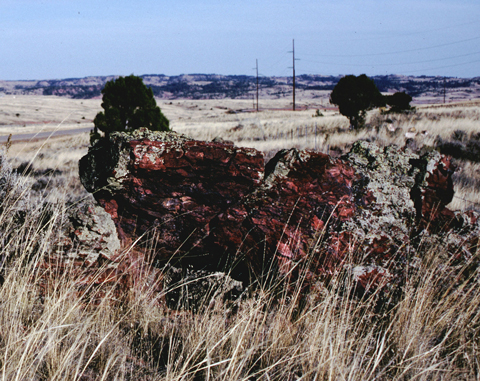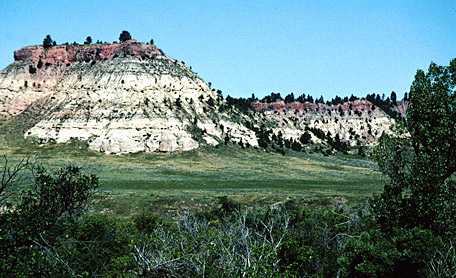Clinker, near Decker, Montana, in the southern end of the Fort Union Formation, far from the Missouri River.
Lewis and Clark began to see products derived from the Fort Union Formation on the Missouri River as far downstream as Blair, in Washington County, Nebraska, on 4 August 1804. It looked to them like pumice stone, so that’s what they called it. (Playing by ear, as usual, Clark spelled it “Pumey Stone,” and “Pumies Stone.”)
But what was Clark’s “pumice stone,” really? How was it formed, and how did it get so far away from its place of origin?
The lignite in the Fort Union Formation ignites easily. Prairie fires may set the coal beds afire, but the coal also will combust spontaneously. Sometimes the materials adjacent to the burning coal beds become so hot that they actually froth and, when cooled, resemble the bubbly and cratered volcanic rock called pumice. Some of it is extremely light because it has so much void space in it (and some of the bubbles contain trapped air) that, if washed away into a river, it can float great distances. Most of the burned coal, however, is clinker, a baked shale, and resembles fragments of brick, as in the photograph above.
The rocks Clark observed had originated more than 450 miles upstream in the Fort Union Formation. Having been washed into the Missouri, or fallen from the riverbank, they had floated downriver, far from their place of origin.
The Corps of Discovery’s entrance into the neighborhood of the Fort Union Formation was signalled—to us, today—by their observation of some “Stone Cole” in a bank near their campsite of October 20, 1804, a few miles south of today’s Mandan, North Dakota.[1]In the eighteenth century the terms stone-coal, pit-coal, and earth-coal were common names for mineral coal, while the word coal alone denoted charcoal, or charred wood. Thus, when Clark mentions … Continue reading They continued to remark on its most conspicuous elements, mainly clinker, varicolored fossils of animals or leaves that were trapped in the sand before it was compacted into rock.”>sandstone, and mudstone. The clinker, or burnt coal beds, create conspicuous brick-red stripe across the faces of many bluffs and buttes where the Fort Union Formation is exposed. The clinker is the product of burning of the coal beds; Lewis and Clark commonly called this the burnt earth, or said that it had “burnt appearances.” Clinker is sometimes called “scoria.” In North Dakota, crushed scoria is frequently used in place of gravel for surfacing country roads.
Notes
| ↑1 | In the eighteenth century the terms stone-coal, pit-coal, and earth-coal were common names for mineral coal, while the word coal alone denoted charcoal, or charred wood. Thus, when Clark mentions that an Indian informant drew a map with a piece of “coal,” we may assume he meant charcoal. See John Entick’s New Spelling Dictionary, first published in London in 1764, and reprinted numerous times in the United States (Early American Imprints, First Series, No. 37375). Furthermore, Biblical references to coal are necessarily to charcoal, since mineral coal has never been found in Palestine. |
|---|


